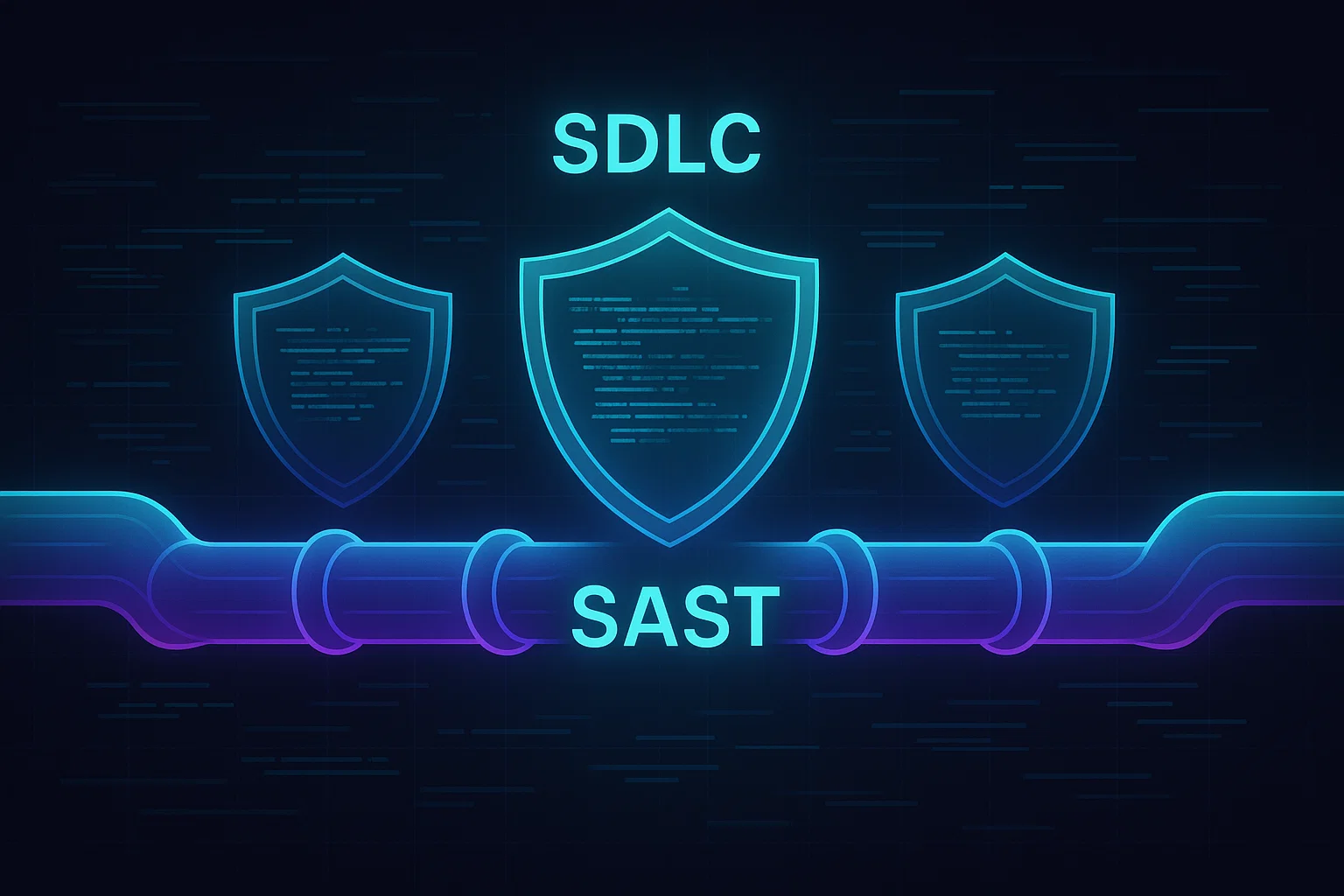DerScanner > Blog > SAST in SDLC

Dan Chernov, DerScanner
SAST in SDLC
For the first time in five years, global data breach costs have declined to an average of $4.44 million in 2025, down 9% from $4.88 million in 2024, primarily due to organizations implementing better security practices like SAST in SDLC throughout their software development processes. However, there's a concerning problem where companies are rushing to use AI technologies without proper SDLC security measures in place.
To address this growing security gap and with cybercrime costs projected to reach $10.5 trillion annually by 2025, integrating Static Application Security Testing into the Software Development Lifecycle has become essential for building resilient applications.
What is SDLC in Cybersecurity?
Understanding what SDLC in cyber security is helps organizations establish a secure software development lifecycle with SAST integration effectively. Organizations implementing cyber security SDLC practices must understand how to implement secure SDLC by creating comprehensive frameworks.
SDLC in security refers to the integration of security practices and controls throughout every phase of the SDLC. This approach transforms traditional development processes into a secure SDLC where security considerations become fundamental rather than afterthoughts.
Security testing in SDLC encompasses various methodologies, including static analysis, dynamic testing, and vulnerability assessments.
Modern development workflows include built-in security checkpoints that act as protective quality gates throughout the SDLC.
A secure SDLC checklist should include automated testing protocols and establish clear guidelines so that security code review is performed throughout the SDLC at every development phase.
The importance of security in SDLC becomes evident when teams establish SDLC security testing procedures that maintain SDLC secure environments. This approach ensures that the final security review in SDLC processes validates all security measures before deployment.
Security testing SDLC processes help identify vulnerabilities before applications reach production environments. This comprehensive approach to SDLC and security enables organizations to build robust applications while maintaining development velocity.
The secure SDLC process guarantees that security risk assessment and mitigation occur consistently throughout development.
What is SAST or static analysis?
Static Application Security Testing (SAST) is a security testing method that examines application source code, bytecode, or compiled binaries without executing the program. Also known as "white-box" testing, SAST in SDLC analyzes code early in the software development lifecycle (SDLC) to identify potential vulnerabilities.
SAST uses automated code analysis techniques to provide comprehensive security analysis. The technology can scan 100% of an application's codebase quickly, which would be impossible for manual review within reasonable timeframes.
One major advantage of static application security testing software is supporting the "shift-left" approach to find and fix vulnerabilities early in development when remediation costs significantly less than addressing issues after deployment.
SAST provides real-time feedback to development teams to help organizations build secure applications from the beginning rather than retrofitting security into comprehensive app security programs.
Vulnerabilities detected by SAST
SAST effectively identifies various vulnerabilities by analyzing source code patterns and programming language structures.
Common Vulnerability Types
- Injection Flaws - SQL Injection, Command Injection, and LDAP Injection attacks
- Cross Site Scripting (XSS) - Script Injection vulnerabilities in web applications
- Buffer Overflows - Memory management issues that can cause system crashes
- Authentication Issues - Weak login mechanisms and session management problems
- Cryptographic Weaknesses - Use of weak encryption algorithms or poor key management
- Input Validation Errors - Improper handling of user input and data validation
- Hard-coded Credentials - Passwords, API keys, and secrets embedded in source code
How does SAST work
Static Application Security Testing SAST follows a systematic analysis process to identify vulnerabilities in code. The process begins when the SAST tool parses the code and constructs an abstract syntax tree (AST), which creates a structured representation of the code's components, including functions, loops, and variables.
The technology performs control flow analysis to identify execution paths and data flow analysis to track how information moves through the application. This dual approach helps detect insecure data handling in different programming languages that could lead to vulnerabilities.
SAST tools contain predefined security rules based on industry standards like OWASP Top 10 and CWE/SANS Top 25. These rules guide pattern matching and semantic analysis techniques to identify code sections that match known vulnerability signatures.
When potential issues are detected, the system flags exact locations in the source code where problems exist. This precise identification helps development teams understand security weaknesses, including hardcoded passwords, weak encryption algorithms, and vulnerable library usage, for effective remediation in their development process.
The SAST lifecycle
The SAST lifecycle represents a continuous process that integrates security testing throughout the secure SDLC.
- Code Development: Developers write and commit new source code or modify existing applications with new features and bug fixes.
- CI/CD Integration: Code commits to version control systems automatically trigger CI/CD pipelines that include SAST analysis as part of automated testing.
- Vulnerability Analysis: SAST tools analyze committed code using predefined security rules. They generate comprehensive reports with severity levels and remediation recommendations.
- Issue Remediation: Development teams review findings and implement necessary changes to address identified security issues while maintaining functionality.
- Retesting Cycle: Updated code gets committed again, triggering another analysis round to validate fixes. This also verifies that no new vulnerabilities were introduced.
How SAST helps meet SDLC security requirements for regulatory compliance
SAST helps organizations meet various regulatory requirements, including FISMA, HIPAA, PCI DSS, GDPR, and NIST SSDF. These SDLC security requirements demand that organizations demonstrate secure coding practices and maintain traceable evidence of security controls throughout their development processes.
Modern SAST tools provide preset configurations specifically designed for different compliance frameworks. Organizations eliminate the need for manual rule configuration with these presets. These configurations provide comprehensive coverage of regulatory requirements while simplifying the compliance verification process.
Key compliance benefits include:
- Automated generation of audit-ready reports
- Traceable documentation of security activities
- Mapping of vulnerabilities to specific regulatory standards
- Continuous monitoring of compliance posture
The technology addresses compliance challenges with centralized dashboards that visualize compliance status and track progress toward regulatory goals.
Organizations reduce audit fatigue when they consolidate scan data and make it easily accessible for both internal teams and external auditors.
SAST vs DAST in SDLC: Key differences
Understanding the differences between static and dynamic application security testing DAST helps organizations build comprehensive security testing strategies.
Testing Approach
SAST operates as "white box" testing, which means it has complete access to the application source code and examines the code structure from the inside out. DAST in SDLC functions as "black box" testing without any knowledge of the underlying code or frameworks, testing applications from outside in, like an actual attacker would.
Application Requirements
- SAST analyzes source code without requiring a running application
- DAST needs fully deployed and running applications to perform testing
- SAST works with code repositories and development environments
- DAST operates against live web applications and APIs
Timing in the Development Process
SAST identifies security vulnerabilities early in the software development lifecycle, often during the coding phase itself. Dynamic Application Security Testing DAST discovers vulnerabilities at the end of development cycles or in production environments.
Vulnerability Detection Capabilities
SAST is good at finding code-level security issues like buffer overflows, injection flaws, and insecure coding patterns. DAST discovers runtime vulnerabilities, configuration problems, and environment-specific security risks.
Cost and Remediation Impact
Development teams can fix SAST findings quickly and efficiently since vulnerabilities are identified during active coding. DAST issues often require more extensive remediation efforts and may delay release schedules.
How SCA and SAST work together
Software composition analysis and SAST provide complementary security coverage for modern applications. SCA focuses on scanning open source and third-party dependencies, while SAST analyzes proprietary code written by internal development teams.
Modern applications contain 80-90% open source components. Therefore, SCA is essential to identify known vulnerabilities in external libraries. SAST examines the remaining proprietary code to find potential security flaws and zero-day vulnerabilities that haven't been publicly disclosed yet.
Complete Security Coverage
- SCA monitors external components and dependencies
- SAST analyzes internal code and custom development
- The combined approach covers 100% of the application codebase
SCA identifies vulnerabilities by comparing components against external vulnerability databases. SAST discovers security issues by analyzing source code patterns and coding practices.
Both integrate into development workflows and CI/CD pipelines to provide continuous security testing throughout the secure software development lifecycle.
SAST vs IAST: Which one should you use?
While SAST examines source code without running the application, IAST takes a different approach by monitoring applications during actual execution — but which one fits your needs?
Key Differences in Approach
SAST performs static code analysis before execution, whereas IAST operates during runtime, similar to DAST. IAST runs inside the application with specialized monitoring tools, while DAST tests from outside like an attacker would.
IAST acts like a security detective inside your application, seeing exactly what happens when problems occur and providing detailed information about where vulnerabilities exist.
Accuracy and Performance
IAST delivers better accuracy with fewer false positives compared to SAST. SAST tools often generate false positives that demand manual review and verification.
Speed Considerations
- IAST delivers real-time feedback at pipeline speeds
- SAST requires longer scan times that can break development workflows
- IAST integrates naturally with existing automated testing
When to Use Each
Deploy SAST for initial code reviews, compliance requirements, and basic vulnerability scanning early in the secure SDLC. Choose IAST for comprehensive pre-production testing and runtime vulnerability detection when you need accurate results with minimal false positives in your development process.
How SAST contributes to RASP
SAST plays an important role in supporting Runtime Application Self-Protection (RASP) by providing the vulnerability intelligence that RASP systems need for effective protection. While SAST identifies security vulnerabilities during development, RASP protects applications from those same vulnerabilities during runtime.
Vulnerability Intelligence Foundation
SAST analysis provides detailed information about potential security issues in source code that RASP can use to implement targeted protection. When SAST identifies security vulnerabilities like injection flaws or authentication weaknesses, this information helps RASP systems understand what types of attacks to look out for during application execution.
The vulnerability patterns discovered through SAST analysis inform RASP about specific code sections that need protection. This intelligence helps RASP systems focus their monitoring efforts on the most critical areas of applications where security risk is highest.
Continuous Protection Strategy
SAST contributes to RASP by identifying vulnerabilities that require immediate protection while development teams work on permanent fixes. RASP provides continuous protection for vulnerabilities found through SAST analysis.
This collaboration between SAST and RASP supports comprehensive security throughout the secure SDLC. Organizations can use insights from the SAST scanner guide to configure RASP protection policies and implement secure development practices that complement runtime security measures.
Popular SAST tools and platforms
The SAST tool market offers various solutions designed to meet different organizational needs and support secure software development lifecycle requirements.
Modern SAST tools integrate seamlessly with CI/CD pipelines and support multiple programming languages to address diverse security testing requirements. Organizations can choose from enterprise-grade solutions to specialized platforms based on their specific security risk management needs.
Leading SAST Platforms:
- DerScanner — Supports analysis of applications written in 43 programming languages, including Java, Python, C#, and JavaScript. Features AI-powered vulnerability triage (DerTriage) and automated patching (DerCodeFix) capabilities. Offers comprehensive SAST Settings configuration and provides detailed results in SAST analysis for a thorough security assessment.
- Splunk — Implements Static Application Security Testing as part of its rigorous secure development approach. This follows industry best practices aligned with security standards and frameworks. Uses SAST alongside dynamic testing for comprehensive product security validation.
- Checkmarx — Offers incremental scans that run only on changed code and IDE extensions that highlight vulnerable lines in real-time. Provides AI-assisted remediation suggestions to guide fixes and predefined presets for compliance frameworks, including HIPAA, PCI, FISMA, NIST, OWASP Mobile Top 10, and SANS Top 25, to make compliance audits easier for security teams.
- Veracode — Recognized as a leading vendor in Static Analysis in the 2025 VDC Research Vendor Impact Awards. Scans over 100 languages and frameworks with unique whole-program analysis that identifies exploitable code. Reduces flaws by up to 60% with IDE scans and provides 40+ integrations into IDEs, CI/CD workflows, and development tools.
Challenges and limitations of SAST
While SAST provides significant security benefits for development teams, organizations must understand its limitations when implementing these tools in their secure SDLC. These challenges can impact developer productivity and tool effectiveness if not properly managed.
False Positives and Accuracy Issues
SAST tools often generate false positives that require manual review to identify real vulnerabilities. Development teams must spend time investigating reported issues that may not represent an actual security risk, leading to decreased trust and reduced productivity in the development process.
Runtime and Environment Limitations
SAST analysis cannot detect runtime issues or environment-specific security misconfigurations since it examines static code without execution. Organizations need complementary testing approaches like dynamic application security testing to identify these runtime vulnerabilities.
Integration and Workflow Challenges
- Time-consuming setup processes discourage tool adoption
- Poor output formatting makes results difficult to understand
- Workflow disruption impacts development speed and momentum
- Limited customizability creates integration difficulties
Complex Issue Resolution
Some security issues identified by SAST require domain-specific expertise from security teams to understand root causes and determine appropriate fixes. Development teams may struggle with complex cryptographic vulnerabilities or dependency-related security issues without additional guidance and support throughout their secure software development lifecycle.
The role of AI in SAST
Artificial Intelligence is transforming how SAST SDLC tools operate, moving beyond traditional rule-based detection to intelligent analysis. Earlier SAST SDLC solutions relied on predefined patterns, often producing many false positives requiring manual review. AI-powered SAST SDLC tools now use machine learning to analyze code more accurately and provide contextual recommendations for vulnerability remediation.
Modern AI integration enables SAST tools to create customized queries through simple prompts rather than requiring expertise in specific query languages. This advancement makes application security testing more accessible to development teams. The integration of AI into security in SDLC processes helps organizations implement security development lifecycle checks more effectively, supporting automated SDLC workflows that enhance both security and development efficiency.
DerScanner's DerTriage feature helps solve the false positive problem that comes with SAST scanning. This smart tool looks at scan results and decides which vulnerabilities are real and which are false alarms. Teams can use DerTriage during scanning or after it finishes. The tool automatically marks findings as "Confirmed" for real problems or "Rejected" for false positives, saving developers time.
DerScanner's DerCodeFix goes one step further by actually fixing the vulnerable code. Instead of only telling developers what's wrong, DerCodeFix looks at the problem code and shows exactly how to fix it. The tool can work together with DerTriage to focus only on confirmed vulnerabilities.The suggested fix always comes with a brief explanation of the changes and guarantees hallucination protection.
For organizations seeking comprehensive AI-powered SAST capabilities, platforms like DerScanner demonstrate how artificial intelligence can enhance traditional static analysis while supporting effective security testing and shifting left security practices in modern development environments.
Share with:
You will definitely like these articles

Static Analysis: How to Do It Right?
2020-04-06
SAST Scanner: A Full Guide
2025-03-31
